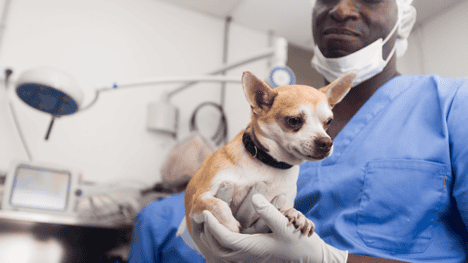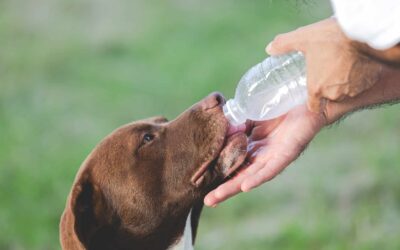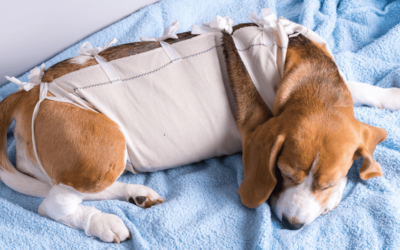How Much Does It Cost to Neuter (Spay) A Dog?

Spaying or neutering your dog is a part of ethical pet ownership, but the thought of paying for the treatment out-of-pocket can be scary.
This article will discuss the differences between spaying and neutering, looking at the benefits of both treatments and what each surgery requires. We’ll also talk about the expenses and how you can lower the cost of the procedure.
Spayed vs. Neutered Dog: What’s the Difference?

The surgical removal of a female dog’s reproductive organs, including the uterus and ovaries, is referred to as spaying, while a male dog’s testicles are surgically removed during neutering. A certified veterinarian performs both procedures while under general anesthesia.
What Are the Benefits of Spaying a Dog?
You should spay your dog for reasons other than population control. The general health and well-being of your pet benefit from this procedure in both medical and behavioral ways.
Medical Benefits
You can protect your female dog from getting illnesses like ovarian cancer, mammary tumors, and uterine infections by having her spayed. The removal of the reproductive organs significantly reduces the likelihood of acquiring these illnesses.
Additionally, female dogs who have undergone spaying are less likely to suffer from pyometra, a potentially lethal illness requiring urgent medical intervention.
Behavioral Benefits
By having your dog spayed, you can keep her from going into heat, which might alter her behavior and attract unwanted attention from male dogs.
What are the Benefits of Neutering a Dog?
There are also several benefits that come from neutering male pets.
Medical Benefits
With neutering, your dog is less likely to develop prostate issues later in life or get testicular cancer. Neutered dogs may actually live longer than unneutered dogs, so prolonging your dog’s lifespan is another benefit to neutering your male pet.
Behavioral Benefits
The behavior of male dogs can be improved by neutering them. It lessens canine hostility against other animals, territorial marking, and the urge to saunter around looking for a mate. Dogs who have been neutered tend to be calmer, less inclined to act destructively, and more attentive to their human friends.
What Is Involved In the Process of Spaying or Neutering a Dog?
Let’s take a deeper look at how the spaying and neutering process differs for male and female dogs:
Male Dogs
Castration, another term for neutering male dogs, entails the surgical removal of the testicles. The testicles are removed by the veterinarian after making a few tiny incisions in the scrotum, and the wounds are then stitched up.
The procedure is normally carried out as an outpatient and is rather simple. Male dogs typically recover quickly and with little difficulty. Within about 7-10 days, your dog should be back to normal activity.
Female Dogs
Compared to neutering male dogs, spaying female dogs is a more invasive surgery. Through an abdominal incision, the uterus and ovaries are removed during this procedure. These reproductive organs are delicately removed by the veterinarian, who then stitches up the wound.
Female dogs may require a little longer to recuperate from spaying because it is a more involved procedure. However, most dogs heal well within 14 days with the right post-operative care and supervision.
The Time Following Surgery
Providing a secure and pleasant environment for your dog to recover after the spaying or neutering procedure is essential. The following advice can help your pet have a smooth recovery from surgery:
Comply with the veterinarian’s instructions
Your veterinarian will give you detailed post-operative care instructions, including how to take your medications, the best ways to care for wounds, and what activities are off-limits.
Create a peaceful and cozy location for your dog to relax in
This will allow your dog to sleep well. Maintain the area’s cleanliness, warmth, and safety from any threats.
Keep a close eye on your dog’s behavior
During the healing process, keep a close check on your dog’s behavior. Watch for any strange behavior, excessive licking, or other indications of discomfort. Contact your veterinarian for advice if you see anything unusual.
Avoid overexertion
Limit your dog’s physical activity while they’re recovering. To avoid problems and make sure that the wound heals properly, stay away from jumping, hard exercise, and rough play.
Use a recovery collar
Your veterinarian may advise wearing an Elizabethan collar (E-collar) to prevent self-inflicted damage if your dog has a tendency to lick or chew at the incision site. There are many different types of surgical collars to choose from, so if your dog is irritated by the plastic, you can look into other options, like cushioned collars.
Maintain a balanced diet and adequate hydration
Give your dog a balanced diet and make sure they always have access to fresh water. Proper recovery is encouraged by a nutritious diet.Your dog may experience appetite changes while they recover, so discuss with their vet what the most suitable diet is in the 72 hours following their surgery.
Keep an eye on the incision site
Check the incision site frequently for any infection-related symptoms like redness, edema, or discharge. Call your veterinarian right away if you notice any alarming signs.
How Much Does It Cost to Neuter or Spay a Dog?
Depending on a number of factors, the cost of neutering or spaying a dog can vary. The size of the dog, its gender, its location, and the veterinary facility or clinic chosen can all affect the price. Generally, you can expect to pay between $340 and $1,500 for the procedure.
Neutering a male dog is usually less expensive than spaying a female dog. Spaying is a more complicated surgical operation that takes more time and resources. Larger canines may also cost more since more anesthetic and surgical supplies are required.
Additionally, the price of veterinary services can fluctuate depending on where you live. It is essential to speak with your neighborhood vet to obtain a precise price quote based on the unique requirements of your dog. Clinics and low-cost or sliding-scale solutions may also be available in your area. Humane societies offer low or no-cost spaying, which can be helpful if you’re on a tight budget.
What Makes Dog Spaying Cost More Than Neutering?
There are a few reasons why spaying is more expensive than neutering. First, the more difficult surgical spaying technique needs a wider incision and more extensive tissue removal. Executing the surgery successfully demands more effort, knowledge, and resources.
Second, because it must be given for a longer duration, the anesthetic used for spaying is often more expensive. Last but not least, recovering female dogs who have been spayed may take a little longer and require more post-operative monitoring and care.
What About Laparoscopic Spay Procedures?
A relatively new and cutting-edge method called laparoscopic spaying provides a less intrusive option to conventional spaying. Smaller abdominal incisions are made with this minimally invasive treatment, and the surgery is visualized and carried out using a specialized camera.
Laparoscopic spaying has a number of benefits, including less pain, smaller incisions, a quicker recovery, and perhaps fewer difficulties. It’s vital to keep in mind nonetheless that not all veterinary facilities might provide the option of laparoscopic spaying. It is best to ask your veterinarian about this method’s availability and go over its benefits and drawbacks if you are interested in using it.
When Should Dogs Be Neutered or Spayed?
The best time to spay or neuter a dog can vary depending on the breed and the owner’s specific needs. There is no one-size-fits-all solution, however, the following general principles should be taken into account:
- Age: Between the ages of six and nine months, most veterinarians advise spaying or neutering. Many pet owners do spay or neuter before six to nine months, even though it’s not ideal, but it’s worth calling out when it’s safe to do the procedure. Although the surgery can still be carried out before any unwanted litters are born, the dogs have normally reached sexual maturity at this point.
- Size and Breed: Larger breeds may benefit from delaying the surgery until they are completely developed. In larger breeds, early spaying or neutering may somewhat raise the risk of specific health conditions, like orthopedic disorders. To establish the best time based on the size and breed of your dog, speak with your veterinarian.
- Health Considerations: It’s vital to discuss the scheduling of the treatment with your veterinarian if your dog has any underlying health conditions. In some circumstances, waiting until your dog’s health has recovered before spaying or neutering may be advised.
- Shelter or Rescue Dogs: A dog you acquire from a shelter or rescue group may have already undergone spaying or neutering. If not, many shelters have policies requiring that the treatment be completed within a certain amount of time following adoption.
To establish the ideal timing for your particular dog, taking into account their breed, size, health status, and any other pertinent aspects, it is imperative to speak with your veterinarian.
Where Can I Get My Dog Neutered or Spayed?

There are various places you can go to spay or neuter your dog. Make sure you do your own research to ensure the doctor and facility you choose are reputable.
Local Clinics and Animal Hospitals
Local veterinary clinics and animal hospitals are the most popular locations to spay or neuter your dog. These facilities have qualified staff members who can carry out the operation safely and offer the required care during the healing process. Contact your veterinarian for a consultation to review the procedure, fees, and any unique requirements.
Animal Shelters and Nonprofit Organizations
Many animal shelters and nonprofit groups provide spaying and neutering services at no cost or at a reduced rate. With the help of these programs, pet owners with low financial means will have easier access to the operations. Find organizations in your area that offer these services by contacting your neighborhood animal shelter or performing an online search.
Mobile Veterinarian Clinics
Some regions have mobile veterinarian clinics that provide treatments for spaying and neutering. These clinics may make many stops on certain days, giving pet owners with trouble getting to conventional veterinary clinics convenient options.
Does Pet Insurance Cover the Cost of Neutering or Spaying a Dog?

Most pet insurance plans do not cover these necessary surgeries. However, when you purchase an Odie pet insurance plan, you can also purchase Odie’s Wellness Plus Plan as an add-on to get reimbursed for spaying or neutering your dog.
Not only does The Wellness Plan ease the burden of paying for your pet’s surgery, but it also covers preventative care that will keep your dog healthy throughout the year for additional peace of mind.



